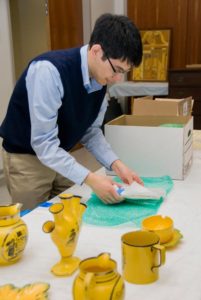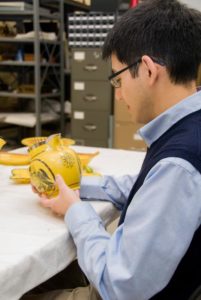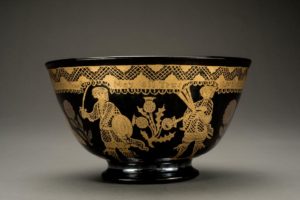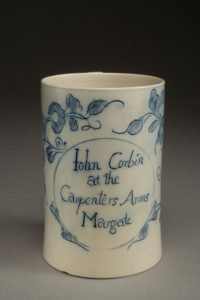Curatorial Intern Examines English Ceramics at Historic Deerfield
EMERGING SCHOLARS > CURATORIAL INTERNSHIP GRANTS
By Daniel Sousa, Historic Deerfield
Through the generous support of the Decorative Arts Trust and the Gerry Charitable Trust, I joined the staff at Historic Deerfield (HD) in January as a curatorial intern. Located in Deerfield, MA, HD’s mission focuses on preserving local and regional history and material culture. The museum achieves this mission through the operation of 12 historic houses, exhibition galleries, a research library, and archives. Having developed a strong interest in early American decorative arts, particularly furniture and ceramics, I was both grateful and enthusiastic for the opportunity to join the museum’s talented curatorial staff and work with their exceptional collection of American decorative arts.
I approach my position at HD with an academic background in American history and experience working with the decorative arts. My studies focused primarily on the Revolutionary, Federal, and Antebellum periods. As a graduate student at the University of Massachusetts, Boston, I explored the topics of early American social, cultural, and religious history while working concurrently at Skinner, Inc. Auctioneers and Appraisers. An internship with Winterthur Museum’s Boston Furniture Archive project also provided me with opportunities to examine objects first hand. This combination of academic and professional training provided me with a critical context and faceted perspective by which to evaluate HD’s notable collections.
At HD I have the great pleasure of working with Curatorial Department Director Amanda E. Lange. In addition to being a talented and well-published ceramics historian, Amanda serves as an excellent mentor as I transition into the field. We are currently focused on a new catalogue of the museum’s extensive English ceramics holdings, which includes the Allistair Sampson collection of English creamware acquired in 2006. The book will highlight exceptional examples in the museum’s holdings, outline the growth and development of the collection, explore the consumption and ownership of English ceramics by Deerfield and Connecticut River Valley residents, and address methods of ceramic production.
To document the ownership of English ceramics by local Deerfield residents, one of my first tasks was to comb through probate inventories spanning the years 1676–1834. This effort generated a database of 143 entries listing the name of the individual, their occupation, the total value of their estate, and transcriptions of ceramics referenced in the inventory and their value. Entries are organized chronologically to demonstrate how the form and composition of ceramics change overtime. Digital images and complete transcriptions of the probate inventories can be quickly accessed for reference. An initial analysis of the content indicates that patterns of ceramic ownership in Deerfield primarily corresponded with that of the larger Connecticut River Valley. In several specific time periods, however, Deerfield residents appear not to own certain forms that were used elsewhere in the Valley.1
To complement the data gleaned from probate inventories I am searching local account books for references to English ceramics and investigating the whereabouts of examples with histories of local ownership. In the future, I also hope to research the existence of any ceramic archaeological fragments held in the collections of local museums and historical societies.
I am also composing object entries for the ceramics catalogue. In addition to providing basic descriptive information (date, dimensions, inscriptions, etc.), each entry also provides the “story” behind the object. Questions related to decoration, design sources, and historical context are some of the many points that will be considered when composing these entries. My object list includes an 18th-century black-glazed and gilt-decorated “Jacobite” punch bowl, an 18th-century delftware shaving bowl, and a Revolutionary War-era creamware plate with a transfer print of A Picturesque View of the State of the Nation for February 1778.
An 18th-century white salt-glazed stoneware mug with scratch-blue decoration is particularly noteworthy. While the form and decoration are quite common, the mug’s inscription sets it apart from other surviving examples: “Iohn Corbin / at the / Carpenter’s Arms / Margate.” Margate likely refers to a small English seaside town in the County of Kent. Research revealed that the John Corbin inscribed on the exterior of the mug was possibly the husband of Mary Ladd, who married April 11, 1762, in Margate, where several sons (including a John) were christened.2 The “Carpenter’s Arms” inscribed on the mug’s exterior may be a reference to a local tavern, but an enterprise of that name operating in 18th-century Margate has not yet come to light.
I am sincerely thankful to the Decorative Arts Trust and Historic Deerfield for allowing me to be a part of the museum’s curatorial staff and for the opportunity to assist with the English ceramics catalogue project. The experience has been enriching and rewarding thus far, and I have enjoyed utilizing my research skills in support of this important endeavor. I look forward to sharing many more interesting discoveries generated through my research and assisting with all stages of the catalogue’s production!
The Decorative Arts Trust is grateful for the generosity of the Gerry Charitable Trust in underwriting Daniel’s internship for 2017. Our curatorial internship program provides invaluable training for the next generation of museum professionals and essential support for our partners in the field. Please let us know if you are able to assist these endeavors with a donation to the Emerging Scholars Program.
1. Ceramics listed in Deerfield probate inventories were compared with Elizabeth Pratt Fox’s analysis of ceramics found in Connecticut Valley estate inventories for the period 1660-1825. See Elizabeth Pratt Fox, “Ceramics and Glass,” in The Great River: Art and Society of the Connecticut Valley, 1635–1820 (Hartford, CT: Wadsworth Athenaeum, 1985), 415–419.
2. Marriage of John Corbin and Mary Ladd, 11 April 1762, England Marriages, 1538–1973, online database available at FamilySearch.org, citing St. John in Margate, Kent, England, reference item 3, Family History Library Microfilm No. 1,737,003. Christening of John Corbin, 13 March 1766, England Births and Christenings, 1538–1975, online database available at FamilySearch.org, citing Margate, Kent, England, reference 1766, Family History Library Microfilm No. 1,886,154.
By Daniel Sousa, Historic Deerfield
Through the generous support of the Decorative Arts Trust and the Gerry Charitable Trust, I joined the staff at Historic Deerfield (HD) in January as a curatorial intern. Located in Deerfield, MA, HD’s mission focuses on preserving local and regional history and material culture. The museum achieves this mission through the operation of 12 historic houses, exhibition galleries, a research library, and archives. Having developed a strong interest in early American decorative arts, particularly furniture and ceramics, I was both grateful and enthusiastic for the opportunity to join the museum’s talented curatorial staff and work with their exceptional collection of American decorative arts.
I approach my position at HD with an academic background in American history and experience working with the decorative arts. My studies focused primarily on the Revolutionary, Federal, and Antebellum periods. As a graduate student at the University of Massachusetts, Boston, I explored the topics of early American social, cultural, and religious history while working concurrently at Skinner, Inc. Auctioneers and Appraisers. An internship with Winterthur Museum’s Boston Furniture Archive project also provided me with opportunities to examine objects first hand. This combination of academic and professional training provided me with a critical context and faceted perspective by which to evaluate HD’s notable collections.
At HD I have the great pleasure of working with Curatorial Department Director Amanda E. Lange. In addition to being a talented and well-published ceramics historian, Amanda serves as an excellent mentor as I transition into the field. We are currently focused on a new catalogue of the museum’s extensive English ceramics holdings, which includes the Allistair Sampson collection of English creamware acquired in 2006. The book will highlight exceptional examples in the museum’s holdings, outline the growth and development of the collection, explore the consumption and ownership of English ceramics by Deerfield and Connecticut River Valley residents, and address methods of ceramic production.
To document the ownership of English ceramics by local Deerfield residents, one of my first tasks was to comb through probate inventories spanning the years 1676–1834. This effort generated a database of 143 entries listing the name of the individual, their occupation, the total value of their estate, and transcriptions of ceramics referenced in the inventory and their value. Entries are organized chronologically to demonstrate how the form and composition of ceramics change overtime. Digital images and complete transcriptions of the probate inventories can be quickly accessed for reference. An initial analysis of the content indicates that patterns of ceramic ownership in Deerfield primarily corresponded with that of the larger Connecticut River Valley. In several specific time periods, however, Deerfield residents appear not to own certain forms that were used elsewhere in the Valley.1
To complement the data gleaned from probate inventories I am searching local account books for references to English ceramics and investigating the whereabouts of examples with histories of local ownership. In the future, I also hope to research the existence of any ceramic archaeological fragments held in the collections of local museums and historical societies.
I am also composing object entries for the ceramics catalogue. In addition to providing basic descriptive information (date, dimensions, inscriptions, etc.), each entry also provides the “story” behind the object. Questions related to decoration, design sources, and historical context are some of the many points that will be considered when composing these entries. My object list includes an 18th-century black-glazed and gilt-decorated “Jacobite” punch bowl, an 18th-century delftware shaving bowl, and a Revolutionary War-era creamware plate with a transfer print of A Picturesque View of the State of the Nation for February 1778.
An 18th-century white salt-glazed stoneware mug with scratch-blue decoration is particularly noteworthy. While the form and decoration are quite common, the mug’s inscription sets it apart from other surviving examples: “Iohn Corbin / at the / Carpenter’s Arms / Margate.” Margate likely refers to a small English seaside town in the County of Kent. Research revealed that the John Corbin inscribed on the exterior of the mug was possibly the husband of Mary Ladd, who married April 11, 1762, in Margate, where several sons (including a John) were christened.2 The “Carpenter’s Arms” inscribed on the mug’s exterior may be a reference to a local tavern, but an enterprise of that name operating in 18th-century Margate has not yet come to light.
I am sincerely thankful to the Decorative Arts Trust and Historic Deerfield for allowing me to be a part of the museum’s curatorial staff and for the opportunity to assist with the English ceramics catalogue project. The experience has been enriching and rewarding thus far, and I have enjoyed utilizing my research skills in support of this important endeavor. I look forward to sharing many more interesting discoveries generated through my research and assisting with all stages of the catalogue’s production!
The Decorative Arts Trust is grateful for the generosity of the Gerry Charitable Trust in underwriting Daniel’s internship for 2017. Our curatorial internship program provides invaluable training for the next generation of museum professionals and essential support for our partners in the field. Please let us know if you are able to assist these endeavors with a donation to the Emerging Scholars Program.
1. Ceramics listed in Deerfield probate inventories were compared with Elizabeth Pratt Fox’s analysis of ceramics found in Connecticut Valley estate inventories for the period 1660-1825. See Elizabeth Pratt Fox, “Ceramics and Glass,” in The Great River: Art and Society of the Connecticut Valley, 1635–1820 (Hartford, CT: Wadsworth Athenaeum, 1985), 415–419.
2. Marriage of John Corbin and Mary Ladd, 11 April 1762, England Marriages, 1538–1973, online database available at FamilySearch.org, citing St. John in Margate, Kent, England, reference item 3, Family History Library Microfilm No. 1,737,003. Christening of John Corbin, 13 March 1766, England Births and Christenings, 1538–1975, online database available at FamilySearch.org, citing Margate, Kent, England, reference 1766, Family History Library Microfilm No. 1,886,154.







